Key Competencies Kit
for Facing Lifelong Learning


 |
This Project has been funded with support from the European Commission. This communication reflects the views only of the author, and the Commission can not be held responsible for any use which may be made of the information contained therein. |
 |
Didactic Unit 3 |
Theme |
Time |
Creativity |
|
3 hours |
|
What is creativity? There are many definitions of creativity all of them refer to a richness of ideas and originality of thinking.
We are all creative every day because we are constantly changing the ideas which we hold about the world about us and our relationship with it. Creativity does not have to be about developing something new to the world, it is more to do with developing something new to ourselves.
Creativity is the ability to:
Creativity and innovation are closely related but different since innovation is using creativity – turning creative ideas into use as products or as active practices.
In order to be creative, you need to be able to view things in new ways or from a different perspective. Among other things, you need to be able to generate new possibilities or new alternatives. The ability to generate alternatives or to see things uniquely does not occur by change; it is linked to other, more fundamental qualities of thinking, such as flexibility, open- mindness.
Creativity can be supported, encouraged and cultivated – as well as weakened, even destroyed.
Most of us were very creative when we were children. Then as we grew up, many of us lost the ability to come up with fresh, innovative ideas. No matter what jobs we currently have, we need the ability to be creative, to find new and better ways of doing things. Would you like to enhance your creativity? Do you think that increased creativity is something that would improve your life?
Before you answer yes or no to that question, take some time to explore what the word “creativity” means to you.
Your idea of a creative person might a painter, artist or writer. All these people are expressing themselves artistically, and they can all rightly be said to be creative people, even if no one else enjoys their art.
What about a single mother who manages to come up with healthy delicious meals on a tiny budget? Isn’t that creativity?
But what about an entrepreneur who has an idea for a new product, who forms a new company to produce and distribute it, eventually employing hundreds of people? Doesn’t this also require creativity?
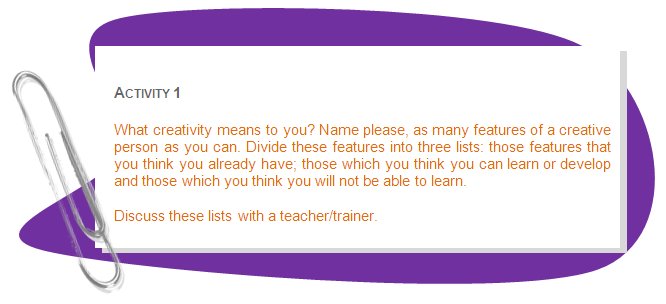
Can we improve our ability to be creative? Yes, in fact, learning to be more creative can be quite enjoyable and easy to do.
As was mentioned above, most of us were very creative as children, before we learned the official rules about how things are supposed to be. We can resurrect our ability to be more creative by exploring some of the many techniques that have been developed to improve creative ability, as well as to improve creative problem solving.
Some of the techniques that are used to improve creativity include brainstorming and creative thinking.
Creative problem solving is a special form of problem solving in which the solution is independently created rather than learned with assistance.
Creative problem solving always involves creativity. However, creativity often does not involve creative problem solving, especially in fields such as music, poetry, and art. Creativity requires newness or novelty as a characteristic of what is created, but creativity does not necessarily imply that what is created has value or is appreciated by other people.
All innovations begin as creative solutions, but not all creative solutions become innovations
 |
The problem solving process consists of a sequence of steps which fit together depending on the type of problem to be solved. These are:
|
 |
The normal process for solving a problem will initially involve defining the problem you want to solve. You need to decide what you want achieve and write it down. |
Often people keep the problem in their head as a vague idea and can so often get lost in what they are trying to solve that no solution seems to fit. Merely writing down the problem forces you to think about what you are actually trying to solve and what you want to achieve.
The first part of the process not only involves writing down the problem to solve, but also checking that you are answering the right problem. It is a check-step to ensure that you do not answer a side-issue or only solve the part of the problem which is most easy to solve. People often use the immediate solution to the first problem definition that they find without spending time checking the problem is the right one to answer.
Understanding where the problem is coming from is crucial when working out whether a solution will actually work or not. Similarly, you must have a set of criteria by which to evaluate any new solutions or you will not know whether the idea is workable or not. Frequently after the investigation people discover that the problem they really want to answer is very different from their original interpretation of it.
Creative thinking is the process, which we use when we come up with a new idea.
Using special techniques, deliberate creative thinking can be used to develop creativity.
New ideas happen when two or more ideas are merged when they have never been merged before. The creative thinking process looks like this:
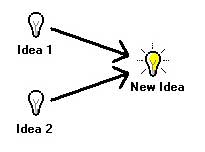
Once you have come up with the new idea, the next hard bit is to make it workable and useable to solve your problem.
Almost every creative idea is a potential solution to a problem.
Before you even think about generating ideas, you need to turn your problem into a challenge. Because if you start generating ideas to solve the wrong problem, you may have great ideas - but they will probably be bad solutions.
1. The best way to get started on turning your problem into a challenge is by writing down your problem in the centre of a sheet of paper. Now, try and break the problem down. Ask yourself "Why is this a problem?", "What is causing this?", "What is behind this?", "What other issues are at stake?" and so on. Ask "why?" until you can no longer answer yourself. Write all of your answers on the sheet of paper. At this stage, the core problem as well as key relevant issues will be apparent. Let's call this the big problem.
2. The next step is to turn the big problem into one or more short, simple challenges. Challenges usually start with
- "In what ways might I/we...?"
- "How might I/we...?"
- "What kinds of... might I/we...?"
Keep your challenges as simple as possible. Avoid:
- Restrictive criteria. Restrictive criteria block creativity. Leave them out of the challenge - but use those criteria later when it comes time to evaluate ideas.
- Combining two or more challenges in a single challenge. Combining two or more issues in a single challenge (such as "how might we earn more income and work less?") Best to divide such challenges into individual challenges and brainstorm one at a time. Start with the most important challenge first.
- Ambiguous challenges. A challenge such as "need money" isn't really clear and is likely to result in ideas that are not really clear. Make your challenges clear to everyone. And phrase them using the words above.
Once you have got your challenge, you will find it remarkably easy to generate ideas that solve it. But before you start brainstorming, there are a couple of things you should bear in mind..
- Generate ideas first. Nothing more. Only after you have finished generating ideas should you even think about reviewing them and decide which one(s) to implement.
- When generating ideas, whether alone or in a group, prohibit any criticism whatsoever. Moreover, it is essential that you make note of every idea no matter how silly, daft or impossible it may seem. The silliest ideas are sometimes the most creative and often highly inspirational.
- Do not stop at the first idea that comes to mind. The first good idea that comes to mind is seldom the most creative - largely because it is almost always the most obvious. Better to generate lots of ideas and then decide which ideas to choose.
Thus the secret to generating great ideas is to start with a great challenge. Then generate, generate, generate ideas.

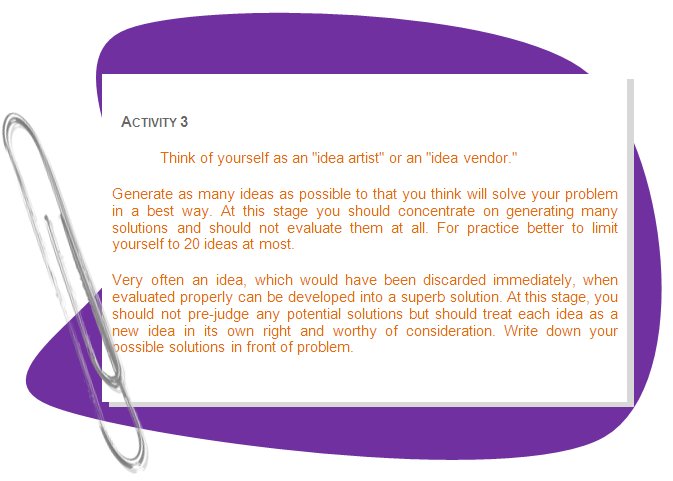
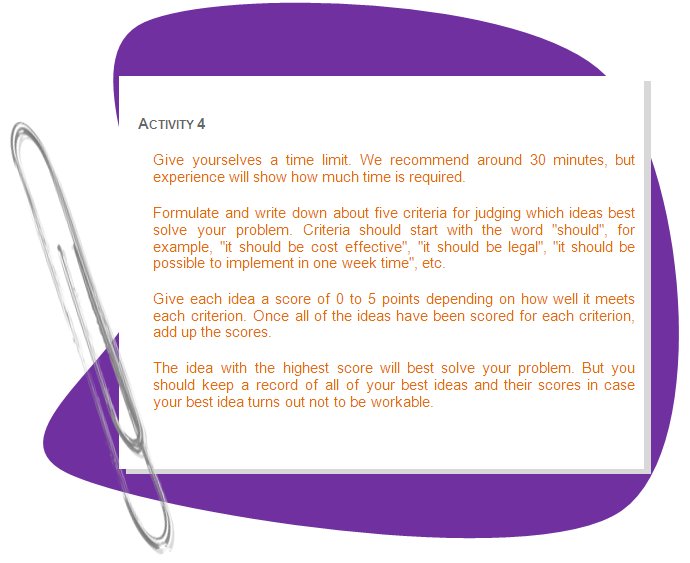
Common myths about creativity 1. “I am not creative”. The truth, of course, is that we are all creative. And while some people are naturally more creative than others, we can all have very creative ideas. The problem is, as we grow older, most of us learn to inhibit our creativity for reasons relating to work, acceptable behaviour and just the notion of being a grown-up. |
There are a number of reasons why creative ideas fail to become innovations. Sometimes it is because the idea, which seems brilliant in concept, is flawed in application.

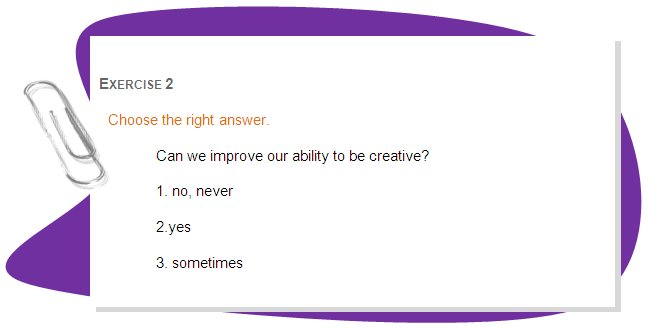
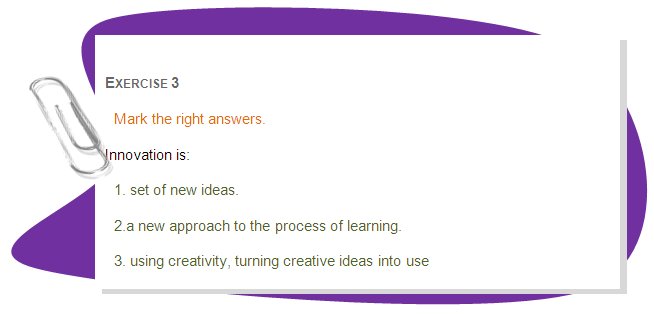
 |
Answers to the questions and exercises of Didactic Unit 3 |
1
2
3